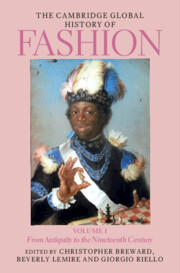Book contents
- The Cambridge Global History of Fashion
- The Cambridge Global History of Fashion
- The Cambridge Global History of Fashion
- Copyright page
- Contents for Volume I
- Figures for Volume I
- Maps for Volume I
- Table for Volume I
- Contributors for Volume I
- Preface
- 1 Global History in the History of Fashion
- Part I Multiple Origins of Fashion
- Part II Early Modern Global Entanglements
- 7 Magnificence at the Royal Courts in the Islamic World
- 8 Early Modern Fashion Cities
- 9 Fashioning Possibilities
- 10 Fashion Beyond Clothing
- 11 Fashion and the Maritime Empires
- 12 Garments of Servitude, Fabrics of Freedom
- Part III Many Worlds of Fashion
- Index
- References
9 - Fashioning Possibilities
Early Modern Global Ties and Entangled Histories
from Part II - Early Modern Global Entanglements
Published online by Cambridge University Press: 04 August 2023
- The Cambridge Global History of Fashion
- The Cambridge Global History of Fashion
- The Cambridge Global History of Fashion
- Copyright page
- Contents for Volume I
- Figures for Volume I
- Maps for Volume I
- Table for Volume I
- Contributors for Volume I
- Preface
- 1 Global History in the History of Fashion
- Part I Multiple Origins of Fashion
- Part II Early Modern Global Entanglements
- 7 Magnificence at the Royal Courts in the Islamic World
- 8 Early Modern Fashion Cities
- 9 Fashioning Possibilities
- 10 Fashion Beyond Clothing
- 11 Fashion and the Maritime Empires
- 12 Garments of Servitude, Fabrics of Freedom
- Part III Many Worlds of Fashion
- Index
- References
Summary
The early modern era (c. 1500–1800) is characterized by the movement of goods and movement of people at an unprecedented scale, interactions described as ‘codependent’.1 The use of ‘early modern’ is argued to be a useful term by James Grehan, reflecting a shared material transformation that defined this age, with goods like tobacco, once known only in the Americas, sweeping the globe by 1600.2 Material innovations of many sorts took hold, manifested in the multiplication of old and new commodities and their wider social manipulation in world communities – shifts in fashion by another name. Diffusion of new material culture did not mean the simple transplanting of goods or the standardization of meanings attached to objects and object systems. Neither colonial nor imperial authorities could wholly impose such values. Indeed, Indigenous scholar Sherry Farrell Racette emphasizes that goods offered by European fur traders to Indigenous North Americans had to conform to existing priorities, with colour and ‘improved function’ equally vital. In this context, ‘[Indigenous] Women literally stitched new goods into daily and ceremonial life.’3 Translation and incorporation are terms applied to the growing complex of materials, a mixing facilitated by new and expanded exchange systems.4
- Type
- Chapter
- Information
- The Cambridge Global History of FashionFrom Antiquity to the Nineteenth Century, pp. 271 - 313Publisher: Cambridge University PressPrint publication year: 2023



